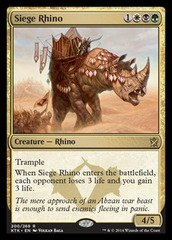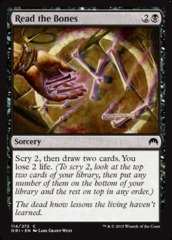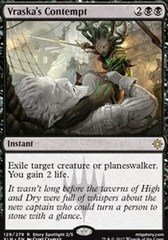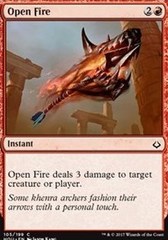Resource Management: One is not Zero, Part 2

Welcome back to Resource Management, my series examining the various resources available to you as a Magic player and how you can use them. In my last article, we looked at how to view your life total as a resource – when it’s correct to allow or prevent damage, and when you should value gaining life or dealing damage directly. If you’d like to catch up, the link to part one follows: Part One
Today, we’re going to look at two other important aspects of life management – incidental life gain or loss, and when you can use your life total as a way to gain information. I won’t be breaking down life as a resource so granularly (see last week’s article for that), so let’s jump right in!
Incidental Life Gain and Life Loss
Around the launch of Khans of Tarkir, there were a few standout cards. Mantis Rider and Monastery Swiftspear more or less propelled Jeskai into the top tier of decks, and Wingmate Roc became a powerful addition to any creature deck that ran white. The card that single handedly inspired both the most lovers and haters, however?

Siege Rhino does it all, and is actually a pretty elegantly designed card – as a four mana 4/5 with Trample, it’s clearly a green creature. The white side of the card is displayed with the life gain, and the black side with life loss. Unfortunately, it’s possible that this mix of stats and abilities was a little too good for Standard.
Last week, I mentioned that life gain and direct life damage were often not worth whole cards unless the strategy they are in is dedicated to that effect (think Soul Sisters or Burn, respectively). So why is Siege Rhino suddenly too good? It’s because the life drain effect is incidental – it comes attached to a board affecting card by itself. Your 4/5 is going to demand an answer, and even if it is immediately killed or trades with a creature, you got a small advantage in the life change. And as everyone knows, Siege Rhino travels in packs. They don’t call it a crash for nothing!
The life change attached to Rhino accomplishes three things.
Firstly, it helps stabilise your own life total. If you are the defending player, a 4/5 blocks well, and that additional three life helps prevent your opponent attacking around it. Even if they do kill it, the three life probably blanks at least one attack, buying you time.
Secondly, it threatens your opponent. The Rhino attacks well, and basically gets one free haste hit in just by entering the battlefield! As above, they always have the second Rhino, and even excluding any other damage, a turn four and turn five Rhino plus an attack cuts your opponents’ life total in half.
Thirdly, it complicates combat math and enables racing. Even if your opponent has been attacking you, a Rhino or two can throw off your opponents’ plan to race completely. Worse still is when you’re attacking them, and they have to choose whether to make a bad block or go to three or less life. Whether you have the Rhino ready or not, your opponent has to respect that you could, and sometimes they’ll choose incorrectly, blocking too passively and losing a guy or just hoping you don’t have one and dying on the spot.
As you can see, incidental life gain or loss can be important. Equally, there are cards that directly trade your life in exchange for another resource. A favourite example of mine?

While this card was in Standard, I often and gladly threw away life to get that sweet, sweet scry on. While life loss effects stack badly – you don’t want ten of these in your deck – the first few give you a discounted rate on a powerful effect in exchange for that life. As long as that effect advances your plan to win the game, the two life is a small cost to pay. By comparison, the closest effect we currently have in Standard is Glimmer of Genius. While Glimmer benefits from instant speed and a couple of energy, Bones has it beat by a full mana in its casting cost!
Then, we also have cards that exclusively gain incidental life. In fact, one of the cards we are likely to see a lot of in Standard (especially if I can help it) is coming in Ixalan:

Now we’ve seen this kind of effect before. Utter End hit any permanent, Anguished Unmaking was cheaper and hit any permanent in exchange for life, and the oft-missed Hero’s Downfall was cheaper but didn’t exile. Even our current Standard after rotation retains Never // Return, a sorcery speed option that’s a little cheaper but comes with a late-game upside.
The problem with four mana removal is that it’s so clunky. Until the late-midgame and on, four mana likely takes up your whole turn. Contempt can exile more or less anything that matters – Chandra, Torch of Defiance, Rhonas the Indomitable and The Scarab God are all fine targets – but sometimes you’ll need to point it at something much cheaper. Longtusk Cub and Kari Zev, Skyship Raider both hit plenty hard for their two mana!
Contempt sweetens the deal by gaining you two life. Now while this is hardly a major upside, it is upside – if having taken your turn off to kill that Cub means you take a hit from a Rogue Refiner, you’ve only actually taken one damage. While I don’t expect this means Contempt will be an auto-four of in every black deck, it’s another mark in its favour, and I expect to see more Contempt than Never // Return in Ixalan standard.
In short, incidental damage and life gain is very desirable. Siege Rhino, Thragtusk, Courser of Cruphix – all excellent cards in their own right, and all format staples during their own Standard seasons.
Life and Information
Now life and information is a little more complex than any of the prior topics covered. Rather than trying to describe in the abstract, I’m going to use an example from limited to illustrate my point.
You are playing a controlling UR deck in HOU limited against an aggressive GW deck, and are on the draw. Your nor opponent didn’t do anything until turn three, when they played a Harrier Naga, a vanilla 3/3 (and a remarkably common play if you follow my articles)! On your turn three, you have an Open Fire at the ready.

You have nothing else to cast, so you recognise you likely need to fire off your removal spell during this turn cycle to avoid falling too far behind. However, Open Fire is an instant, so you decide to see if you can nab a two for one on your opponent, and pass.
Your opponent untaps, moves straight to combat, and sends their Naga at you. You say no blocks, and they pass priority right back to you. Uh oh! They didn’t go for an aura, and now your removal spell risks getting blown out by a combat trick. So why didn’t you cast Fire during your turn?
The reason is simple. You take the three damage, and you let your opponent move to their postcombat main. They play a fourth land, and cast a Quarry Hauler. Bingo! You found a better target for your removal spell. Fire away! Hauler down, and now you can comfortably play your X/4 creature ready to block the Naga on turn four.
Now sometimes, in this same situation, your opponent may miss their fourth land, and cast nothing after combat. In that case, you took three damage for nothing… right? Well, no.
Regardless of exactly how this scenario plays out, you have made a conscious decision to trade your life total for information. By allowing the Naga attack, you can see whether you need to use your Fire on it, whether they give you a better target, or whether you even need to cast it at all – if they don’t make another play and Fire is your only removal spell, you may even decide to hold onto it – that X/4 in your hand is going to block it anyway.
Typical Control decks in constructed use their life total very liberally when it comes to gaining information. It’s pretty common that they may take ten or more damage from their opponents’ early plays, and keep removal/counterspell mana up for the bigger threats. When they’re finally able to cast two spells in one turn, then it’s time to deal with the two drops.

The same principle doesn’t always apply to removal spells, however. It’s possible you may want to not block your opponents’ creatures as you think you’re in a position to race them – that is, trade damage with them, thinking they’ll die first. Then, post combat, you can see what they play, decide if racing is still a good idea, and go from there. If you snap trade your three drop with their two drop and they have no follow-up, you’ve missed an opportunity to initiate a damage race you could likely win.
Like everything in Magic, there is no hard and fast rule on when it is correct to take damage in exchange for information – versus Standard Ramunap Red, I would generally not advise it, for example – but even then, it’s situational. The better you know a format, and the more comfortable you are with a matchup, the more likely you are to know when taking damage will give you an opportunity to make stronger plays.
Summary
The life total is one of the simplest and most intricate resources to manage in Magic. Whether you’re using it to gain information or buy time; pressuring your opponents’ life total to minimise their card advantage on you; or chump blocking to try and get one extra draw step, it’s a tool you should always be acutely aware of. I hope this two-parter has helped you to see it in a new light, or solidify concepts you’d never put to paper.
Next up, we’ll be looking at mana as a resource. In the meantime and as always, if you have any questions or ideas, please leave them in the comments below. Good luck!





